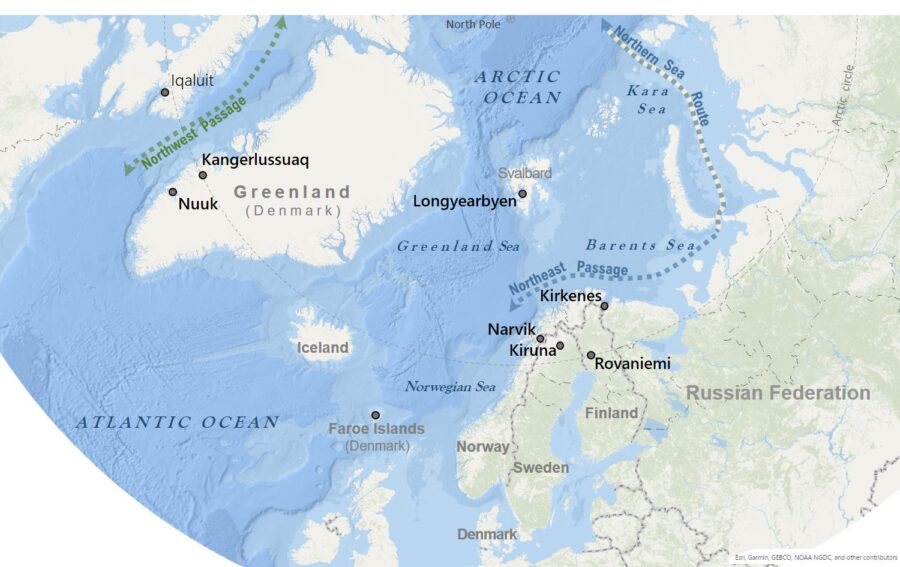European Arctic
The European Arctic is the most heterogeneous of the three study regions and comprises territories of five states: Denmark (including Greenland and the Faroe Islands), Finland, Iceland, Norway, and Sweden. In comparison to other parts of the Arctic, the region has a relatively well-developed transport infrastructure, especially in northern Fennoscandia. Still, compared to the political centers of Fennoscandia, the region is characterized by a declining rural population, sparse settlements, and long travel distances, both within the region and to external markets. This, in conjunction with the Arctic being viewed as a strategically important region, has resulted in large resource allocations by the respective states for development and infrastructure projects. Infrastructure development across the nations is of major concern to regional cooperation initiatives, such as the West Nordic Council and the Barents Euro-Arctic Transport Area, which seek to foster economic and social development by strengthening transport corridors both within the region and to external markets. Since the beginning of Russia’s invasion of Ukraine in February 2022 and with Finland’s and Sweden’s joint NATO application, the importance of military presence and military co-operations has significantly risen. This study region consists of the following case study areas, which are located in the map below:
- Longyearbyen/Svalbard
Longyearbyen, Svalbard is a former coal-mining company town at the tail end of economic restructuring and is today a tourist town with a strong research and education sector. The town is of great geo-political importance for Norway as it ensures Norwegian presence on Svalbard and the high Arctic. Due to its insular location and busy airport, Longyearbyen is at the same time remote and central. An upgrade of the port in order to make it a central hub along the NSR is a central part of Norway’s Arctic strategy.
- Kirkenes & Rovaniemi
Kirkenes, Norway is located at the Barents Sea coast at the border with Russia. The former mining town that has been long identified as a multicultural cross-border community with strong ties to Russia, since the beginning of the war is now in search for a new identity. Its natural ice-free seaport bears potential for situating Kirkenes as a major transportation hub along the Northern Sea Route, but so far it lacks connection to the rail network.
Rovaniemi is the capital of Finnish Lapland and is a well-connected tourism town by flights to several European cities. While the railway connection to southern Finland is operational, a connection to the Northern Sea Route is missing with several plans and imaginaries to find efficient new routes of transport infrastructures.
- Kiruna & Narvik
Kiruna is a historical mining town located in the Swedish Arctic is undergoing a profound change as a large portion of the town is currently being relocated effecting Indigenous Sámi and local residents’ lives. The transportation of iron ore from Kiruna to the ice-free port in Narvik continues to shape local communities in times of the new “green transition phase” with rising global demands for iron ore.
Narvik, Norway constitutes a major infrastructure intersection connecting the railway from Swedish mining towns to the Northern Sea Route, and is striving to become the biggest ice-free port north of the Polar Circle. In recent years tourism has gained importance with cruise ships bringing thousands of passengers to the northern industrial town.
- Faroe Islands
This sub-Arctic archipelago consisting of 18 islands is an autonomous territory within the Kingdom of Denmark. Being uninhabited until the 9th century, the islands have recently surpassed 50,000 inhabitants. The Faroese economy is dominated by the fishing industry; however, after the fisheries collapse in the early 1990ies, the country is trying to diversify their activities. Tourism is an emerging sector. In the last decades, the Faroese government started an ambitious plan to interconnect the islands via tunnels and bridges, including several sub-seas tunnels, in order to stop and revert population losses in the most remote municipalities, and to avoid greater concentration in the capital of Tórshavn.
- Greenland
While Greenland (Kalaallit Nunaat) is the largest island in the world, there are no roads or railways that link the almost 70 communities that dot the island’s coasts. The country’s air transit system, instead, serves as its main source of year-round mass transport, linking communities and businesses together and creating access to the globe. A legacy of its colonial past, American military activities during World War II, and the early years of its former Home-Rule government, this network of airports, heliports, and helipads is set to be realigned by the country’s new airport expansion package. Part of a broader vision for the country’s future, which is both independent and international, the plan promises to increase tourism, trade, and travel possibilities through the construction of two additional international airports and one new regional hub, while additional locations for new airports are under discussion. Yet, the increased connection expected by new airports will also upend much of the island’s current transportation network increasing access to some communities while potentially contributing to the isolation and displacement of others. Study communities include Nuuk/Kangerlussuaq and Tasiilaq.

